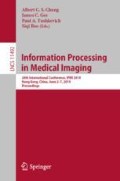Abstract
Oriented elements compose fibrous structures in biological tissue, and their geometry plays an important role in organ function. In the heart, for example, myocytes are stacked end on end in a particular fashion to facilitate electrical conductivity and efficient mechanical contraction. In the brain, white matter fiber tracts are neuro-anatomically partitioned into specific bundles which connect distinct brain regions. In both cases, the local geometry has been qualitatively described as being sheet-like in particular regimes. Yet, to date, few if any quantitative methods exist for finding these sheets from imaging data. We here introduce a novel computational solution to this problem, motivated by the property that a holonomic vector field is locally normal to a family of smooth surfaces. We propose an algorithm which, given an input vector field, finds a second one with which it best spans a sheet-like structure locally, by minimizing non-holonomicity. We show that our algorithm converges in theory and in practice, under reasonable assumptions about the input data, and we provide high quality sheet reconstructions from both heart wall DTI data and labeled tracts in the human brain, along with a sheet likeliness measure. Whereas sheet-like geometries have been described qualitatively in past literature, ours is the first method to provide a reconstruction of them from a single direction field. Our algorithm also admits a parallel implementation that exploits GPUs and is hence very efficient. We thus anticipate that it will find use in the community for retrieving sheets on which oriented fibrous structures lie from imaging data.
B. Samari and T. A. Syed—Equal contribution.
Access this chapter
Tax calculation will be finalised at checkout
Purchases are for personal use only
References
Ankele, M., Schultz, T.: A sheet probability index from diffusion tensor imaging. In: Kaden, E., Grussu, F., Ning, L., Tax, C.M.W., Veraart, J. (eds.) Computational Diffusion MRI. MV, pp. 141–154. Springer, Cham (2018). https://doi.org/10.1007/978-3-319-73839-0_11
Catani, M., Bodi, I.: Dell’Acqua: comment on “the geometric structure of the brain fiber pathways”. Science 337(6102), 1605 (2012)
Dou, J., Tseng, W.Y.I., Reese, T.G., Wedeen, V.J.: Combined diffusion and strain MRI reveals structure and function of human myocardial laminar sheets in vivo. Magn. Reson. Med. 50(1), 107–113 (2003)
Gilbert, S.H., Benson, A.P., Li, P., Holden, A.V.: Regional localisation of left ventricular sheet structure: integration with current models of cardiac fibre, sheet and band structure. Eur. J. Cardio-Thorac. Surg. 32(2), 231–249 (2007)
Haije, T.C.J.D.: Finsler geometry and diffusion MRI. Ph.D. thesis, Eindhoven University of Technology (2017)
Helm, P., Beg, M.F., Miller, M.I., Winslow, R.L.: Measuring and mapping cardiac fiber and laminar architecture using diffusion tensor MR imaging. Ann. N. Y. Acad. Sci. 1047(1), 296–307 (2005)
LeGrice, I.J., Smaill, B.H., Chai, L.Z., Edgar, S.G., Gavin, J.B., Hunter, P.J.: Laminar structure of the heart: ventricular myocyte arrangement and connective tissue architecture in the dog. Am. J. Physiol. 269(2), H571–82 (1995)
Lombaert, H., et al.: Human atlas of the cardiac fiber architecture: study on a healthy population. IEEE T-MI 31(7), 1436–1447 (2012)
Maier-Hein, K.H., et al.: The challenge of mapping the human connectome based on diffusion tractography. Nat. Commun. 8(1), 1349 (2017)
Paszke, A., et al.: Automatic differentiation in pytorch (2017)
Peyrat, J.M., Sermesant, M., Pennec, X., Delingette, H., Xu, C., et al.: A computational framework for the statistical analysis of cardiac diffusion tensors: application to a small database of canine hearts. IEEE T-MI 26(11), 1500–1514 (2007)
Savadjiev, P., Strijkers, G.J., Bakermans, A.J., Piuze, E., Zucker, S.W., Siddiqi, K.: Heart wall myofibers are arranged in minimal surfaces to optimize organ function. Proc. Natl. Acad. Sci. 109(24), 9248–9253 (2012)
Tax, C.M., et al.: Sheet probability index (SPI): characterizing the geometrical organization of the white matter with diffusion MRI. NeuroImage 142, 260–279 (2016)
Tax, C.M., et al.: Quantifying the brain’s sheet structure with normalized convolution. Med. Image Anal. 39, 162–177 (2017)
Wedeen, V.J., Rosene, D.L., Wang, R., Dai, G., et al.: The geometric structure of the brain fiber pathways. Science 335(6076), 1628–1634 (2012)
Young, R.J., Panfilov, A.V.: Anisotropy of wave propagation in the heart can be modeled by a riemannian electrophysiological metric. Proc. Natl. Acad. Sci. 107(34), 15063–15068 (2010)
Yu, A.: The Geometry of Vector Fields. Gordon & Breach Publ. (2000)
Yushkevich, P.A., Zhang, H., Simon, T.J., Gee, J.C.: Structure-specific statistical mapping of white matter tracts. NeuroImage 41(2), 448–461 (2008)
Acknowledgments
We are grateful to NSERC (Canada) and FRQNT (Québec) for funding that has supported this research.
Author information
Authors and Affiliations
Corresponding author
Editor information
Editors and Affiliations
Rights and permissions
Copyright information
© 2019 Springer Nature Switzerland AG
About this paper
Cite this paper
Samari, B., Syed, T.A., Siddiqi, K. (2019). Minimizing Non-holonomicity: Finding Sheets in Fibrous Structures. In: Chung, A., Gee, J., Yushkevich, P., Bao, S. (eds) Information Processing in Medical Imaging. IPMI 2019. Lecture Notes in Computer Science(), vol 11492. Springer, Cham. https://doi.org/10.1007/978-3-030-20351-1_14
Download citation
DOI: https://doi.org/10.1007/978-3-030-20351-1_14
Published:
Publisher Name: Springer, Cham
Print ISBN: 978-3-030-20350-4
Online ISBN: 978-3-030-20351-1
eBook Packages: Computer ScienceComputer Science (R0)

